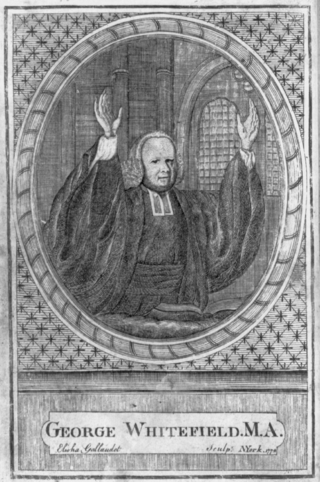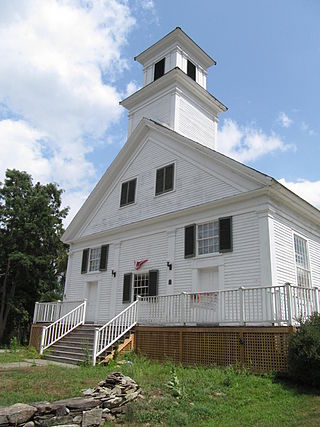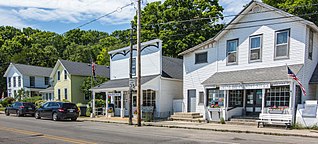This timeline of Christian missions chronicles the global expansion of Christianity through a listing of the most significant missionary outreach events.

The camp meeting is a form of Protestant Christian religious service originating in England and Scotland as an evangelical event in association with the communion season. It was held for worship, preaching and communion on the American frontier during the Second Great Awakening of the early 19th century. Revivals and camp meetings continued to be held by various denominations, and in some areas of the mid-Atlantic, led to the development of seasonal cottages for meetings.

The Presbyterian Church of Wales, also known as the Calvinistic Methodist Church, is a denomination of Protestant Christianity in Wales.

Andrew Hunter (1813–1902) was a noted Methodist preacher, sometimes referred to as "The Grand Old Man of Arkansas", "The Patriarch of Methodism", "The Nestor of Methodism in Arkansas", and "The Foremost Churchman in Arkansas".

The Christian Munsee are a group of Lenape, an Indigenous people in the United States, that primarily speak Munsee and have converted to Christianity, following the teachings of Moravian missionaries. The Christian Munsee are also known as the Moravian Munsee or the Moravian Indians, the Moravian Christian Indians or, in context, simply the Christian Indians. As the Moravian Church transferred some of their missions to other Christian denominations, such as the Methodists, Christian Munsee today belong to the Moravian Church, Methodist Church, United Church of Canada, among other Christian denominations.

Peter Jones was an Ojibwe Methodist minister, translator, chief and author from Burlington Heights, Upper Canada. His Ojibwa name was Kahkewāquonāby, which means "[Sacred] Waving Feathers". In Mohawk, he was called Desagondensta, meaning "he stands people on their feet". In his youth his band of Mississaugas had been on the verge of destruction. As a preacher and a chieftain, as a role model and as a liaison to governments, his leadership helped his people survive contact with Europeans.
The Methodist Mission was the Methodist Episcopal Church's 19th-century conversion efforts in the Pacific Northwest. Local Indigenous cultures were introduced to western culture and Christianity. Superintendent Jason Lee was the principal leader for almost a decade. It was a political and religious effort. Two years after the mission began, the church's Board of Foreign Missions described its intent to reclaim "these wandering savages, who are in a very degraded state, to the blessings of Christianity and civilized life." Alongside the missions founded in the region were several secular operations opened. These were maintained to allow for material independence from the Hudson's Bay Company (HBC), then the preeminent economic entity in the region among European descendants.
Jesse Bushyhead was a Cherokee religious and political leader, and a Baptist minister. He was born near the present-day town of Cleveland, Tennessee. As a young man, he was ordained a Baptist minister.

Peter Nead was an American preacher in the German Baptist Brethren church that descended from the Schwarzenau Brethren. He wrote several theological works, which were influential in the Old German Baptist Brethren and related churches, perhaps the most prominent being "A Vindication of Primitive Christianity."

Christianity in the 18th century is marked by the First Great Awakening in the Americas, along with the expansion of the Spanish and Portuguese empires around the world, which helped to spread Catholicism.

The Asbury United Methodist Church is a historic Methodist church on NH 63 in Chesterfield, New Hampshire. It has been termed the "mother church of Methodism in New Hampshire", and is home to the state's oldest continuously running Methodist congregation, organized in 1795. The building, constructed in 1844, is a prominent local example of Greek Revival architecture, and was listed on the National Register of Historic Places in 1983.

Thomas Birch Freeman was an Anglo-African Wesleyan minister, missionary, botanist and colonial official in West Africa. He is widely regarded as a pioneer of the Methodist Church in colonial West Africa, where he also established multiple schools. Some scholars view him as the “Founder of Ghana Methodism”. Freeman's missionary activities took him to Dahomey, now Benin as well as to Western Nigeria.
The Allegheny Wesleyan Methodist Connection (AWMC), originally the Wesleyan Methodist Church (Allegheny Conference), and also known as the Wesleyan Methodist Church (WMC), is a Methodist denomination within the conservative holiness movement primarily based in the United States, with missions in Peru, Ghana, and Haiti.

St. Paul's United Methodist Church is located in downtown Cedar Rapids, Iowa, United States. The Louis Sullivan-designed building has been individually listed on the National Register of Historic Places since 1985. In 2000 it was included as a contributing property in the Second and Third Avenue Historic District.

The Zeba Indian United Methodist Church is a religious building located at 227 Front Street in Zeba, Michigan, northeast of L'Anse. It marks the site of the Kewawenon Mission, built in 1832, which was the birthplace of Indian Methodism in the western Upper Peninsula, and predated Frederic Baraga's mission at Assinins by 11 years. It was listed on the National Register of Historic Places in 1980 and designated a Michigan State Historic Site in 1979.
The Mission Church is a historic Episcopal log church building on the eastern fork of the Chandalar River in Arctic Village, Alaska, inside the Arctic National Wildlife Refuge. Known also as Old Missionary Church and as Old Log Church, it was built in 1917. It was one of numerous mission churches established in Alaska by the Episcopal Church in the early 20th century.

Hinde Street Methodist Church in Hinde Street, Marylebone, London, is Grade II listed with Historic England. It was built 1807-10 and rebuilt in the 1880s.

The Omena Historic District is a historic district located along M-22 from Tatch Road to North Omena Point Road in Omena, Michigan. It was listed on the National Register of Historic Places in 2017.

Trinity-St. James United Methodist Church is located in Cedar Rapids, Iowa, United States. The congregation began as a Sunday school in the northwest part of the city organized by Trinity Methodist Episcopal Church. The evangelist Billy Sunday had preached a revival there and over 300 people joined the church. St. James Methodist Episcopal Church, as it was then known, was established shortly afterward in February 1910. The congregation originally used the closed Danish Lutheran Church at K Avenue NW and Fourth Street NW for their services, and they moved the building that summer to Ellis Boulevard NW. St. James grew to the point that a new building was needed. In 1945 property across the street was purchased, and local architect William J. Brown designed the new church facility. Construction began in September 1952 and it was completed in April 1954 for $165,000.

In Methodism, a steward is a member of a local church who is elected by the congregation to help in the practical life of the church. The position of stewards is a hallmark of classic Methodism.















